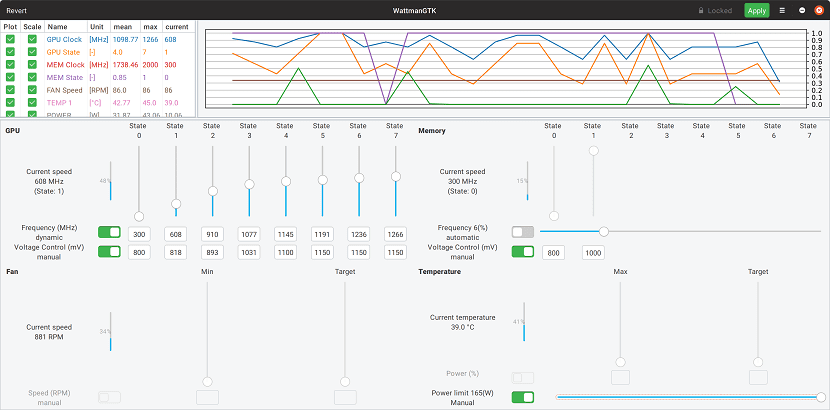
In the previous article we talked about TuxClocker which is a tool to overclock Nvidia cards in Linux and well in this other article now it's the turn of another tool for AMD video cards.
The tool that we will talk about today is WattmanGTK which is a GTK interface for overclocking AMD video cards.
About WattmanGTK
From the available functions, it is possible to view memory status and performance modes (P state) of the GPU, tracing the changes in the data of the integrated sensors on the GPU (temperature, GPU frequency, video memory frequency, fan speed).
WattmanGTK cannot directly control frequency and voltageIt only generates parameters for the amdgpu driver, which needs to be passed when loaded using the «amdgpu.ppfeaturemask»(A ready shell script can be generated in the output to apply the settings).
The program also does not support changing the operating parameters of the cooler and cannot simultaneously monitor the work of multiple GPUs.
WattmanGTK is written in Python and is available under the GPLv2 license.
It is important to mention that this tool only works with video cards that make use of the AMDGPU driver, so it is not useful for older cards.
Another important point to mention is that WattmanGTK is only responsible for providing the user with the instructions and the parameters necessary for the user to apply these to the configurations of his card. So these actions are at the user's own risk and neither the creator of the application nor anyone is responsible for the use of this application, only the end user.
How to install WattmanGTK on Linux?
If you want to install this AMD video card overclocking tool on your Linux distro, You just have to follow the instructions that we share below.
The first thing we are going to do is download the installer, for this we are going to open a terminal and in it we are going to type the following command:
git clone https://github.com/BoukeHaarsma23/WattmanGTK
Done this now we will access the downloaded folder:
cd WattmanGTK
Being inside the folder now We just have to run the installer, we do this by typing the following command:
sudo python3 setup.py install
Here we will only have to wait for the installation to be resolved and we will not have any errors. Installation is complete the wattmanGTK command is available from now on to be able to execute it in our terminal.
Alternatively, the tool can also be started from the folder that we downloaded and by opening a command line positioned in it, we can execute it with the following command:
python3 run.py
When they want to apply the configuration given in the GUI, they just have to click on apply and instructions will be given on how to apply the overclock.
The core overdrive parameter must be configured.
How to know if overdrive is activated?
To know this we just have to try to run WattmanGTK, by doing this the same tool will tell you if your card supports overdrive or not.
Even if this is not the case, it is possible to configure a kernel parameter to force overdrive activation (may not work on all cards).
For GRUB-based systems we only have to edit one line of our grub configuration.
We can do this by opening a terminal and in it let's edit the / etc / default / grub file and find the line:
GRUB_CMDLINE_LINUX_DEFAULT="quiet splash"
Once the line has been identified, now we only have to change it so that it is as follows:
GRUB_CMDLINE_LINUX_DEFAULT="quiet splash amdgpu.ppfeaturemask=<the suggested value by WattmanGTK>"
At the end of the changes we only have to save them to be able to apply them. After that we just have to execute the following command:
sudo update-grub
Or we can execute any of the following commands:
In BIOS systems:
sudo grub2-mkconfig -o /etc/grub2.cfg
On UEFI systems:
sudo grub2-mkconfig -o /etc/grub2-efi.cfg
For more information, you can consult the following link.